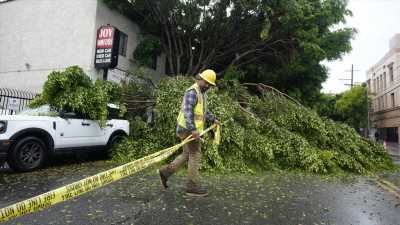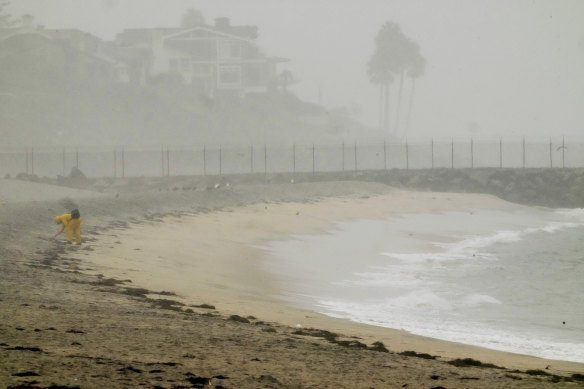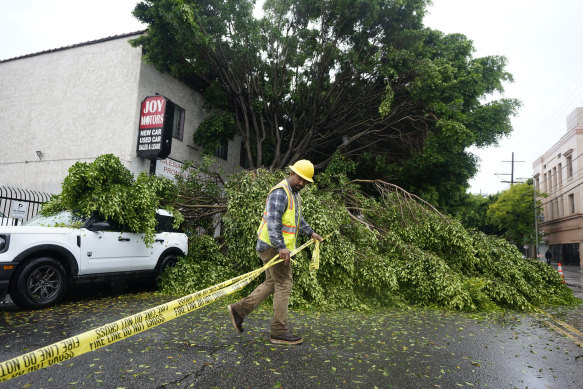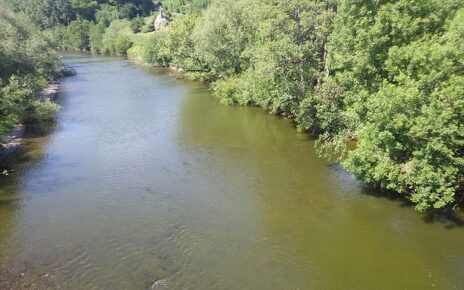Save articles for later
Add articles to your saved list and come back to them any time.
After months of sweltering summer heat and temperatures in the early 30s, residents of the California cities of Los Angeles, San Diego and Palm Springs woke this morning to a blanket of grey storm clouds rolling in from the south.
Hurricane Hilary had arrived.
While the prevailing mood was relatively calm – quiet streets, no pedestrians and few cars on the road, in an unsettling echo of the 2020 pandemic shutdown – there were reports of flooded streets and some mudslides.
At the beach in Carlsbad, California as the state prepares for flooding.Credit: AP
Then, just before 2:45pm local time, an earthquake shook the city for a few seconds.
On any other day, it might have been ignored. But on a day of extreme weather and already frayed nerves, it added a Biblical dimension to an otherwise already tense situation.
The US Geological Survey reported a 5.5 magnitude earthquake, centred 7.2 km south-east of the central California city of Ojai. Seconds after the quake, the USGS automated emergency notification system buzzed mobile phones with a warning: “Earthquake Detected! Drop, Cover, Hold On. Protect Yourself.” And in the wake of the tremor, the USGS reported a swarm of aftershocks.
With regard to the storm, in many respects the media coverage runs well ahead of actual events; when TV news presenters were talking about the hurricane’s impact on cities yesterday, it was still out at sea, and as they predicted its route through California, it was still yet to make landfall.
That will change today, as the hurricane – now downgraded to a tropical storm – actually starts to move along the route predicted by the National Weather Service: through the city of San Diego and into central California, cutting a line along the mountains that will take it between Los Angeles and Palm Springs towards the neighbouring state of Nevada.
At 8am Monday AEST, Hilary was located about 160 km south-southeast of San Diego, and moving north at around 35 km/h.
Heavy rain and high wind are expected in San Diego Monday morning, Australian time, with the damaging weather system to reach Los Angeles and Palm Springs around late Monday afternoon and into Monday evening.
A worker drags caution tape to block off a fallen tree in Los Angeles. Tropical Storm Hilary is still carrying so much rain that forecasters said “catastrophic and life-threatening” flooding is likely.Credit: AP
While the anticipated disaster is not likely to fully eventuate, authorities in California this morning warned the worst is still yet to come.
“[People] need to stay home,” San Diego Sheriff Kelly Martinez said. “We need to really heed the warnings that the worst of the storm has yet to come.”
Evacuation orders have been given to parts of Azusa and Riverside, both of which abut Los Angeles County.
Azusa is just 40 km from downtown Los Angeles. Flash flooding has also been reported in Death Valley National Park, north-east of Los Angeles.
The hurricane, which formed initially as a tropical storm in an area of low pressure off the southern coasts of Mexico, Guatemala, and El Salvador, reached hurricane strength last week.
By yesterday it had been downgraded to a category one tropical storm. When it made landfall at San Quintín, Baja California, it was still delivering winds of around 105 km/h.
One person drowned in the Mexican town of Santa Rosalia, on the Baja California peninsula, when a vehicle was swept away by floodwater. Four people were rescued from the same incident.
More than one thousand flights have been cancelled as a result of the storm; just more than half of those are in or out of San Diego and Las Vegas.
Los Angeles International Airport has cancelled 79 flights, but is also reporting almost 200 flight delays. Those numbers are expected to increase.
Meanwhile, Nevada governor Joe Lombardo has declared a state of emergency due to the “imminent impact” of the storm, as it crosses California and into Nevada. The storm could cause “significant damage to state infrastructure and public and private property”, Lombardo said.
Get a note directly from our foreign correspondents on what’s making headlines around the world. Sign up for the weekly What in the World newsletter here.
Most Viewed in World
From our partners
Source: Read Full Article



